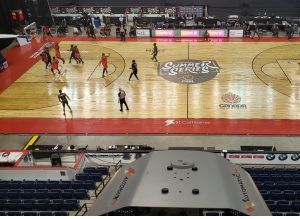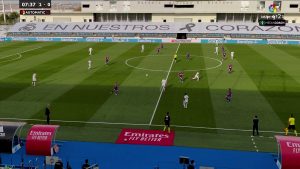SVG Tech Insight: The Future of Production Is Automatic, Flexible, and Remote — and 'Hands Off'
This fall SVG will be presenting a series of White Papers covering the latest advancements and trends in sports-production technology. The full series of SVG’s Tech Insight White Papers can be found in the SVG Fall SportsTech Journal HERE.
As sports competitions resume around the world, a number of leagues (MLB, LaLiga, Premier League) are playing games in their home venues, while others —like the NBA, MLS, Canada’s CEBL and CPL, and Spain’s ACB Liga — have opted for the single hub model. Match productions have had to adapt to fit stringent new requirements set out by the venues, teams, and local health authorities.
When covering major sports events, broadcasters typically deploy a large crew and range of cameras, from beauty cams to large cameras on tripods, Ultra SloMo, and Skycams, as well as the relevant audio and graphic systems — but such a set-up can be unaffordable or impractical for many organizers. However, there are now a range of mature automatic production solutions that allows them to produce professional coverage on restricted budgets. These increasingly sophisticated technologies permit rights holders to maximize returns while retaining quality and improving the flow of data and analysis available to referees and coaches.
To decide which system to choose, the first step is to define the camera plan and decide which and how many of these cameras will be automated, in line with available budget. Each sport has its own specifications, and the master camera of an automatic system can deliver streams automatically without human intervention by using a very accurate Artificial Intelligence (AI) engine.
The most cost-effective solution involves a single automatic master camera, including overlays and audio. Very few solutions offer a multicamera production — that is, at least two more cameras in addition to the master one, with switching between the different cameras automatically. Some solutions permit the integration of human-operated cameras, which enhances the production with close-up views. The switching, in this case, is manually operated.
With all these options, a broadcaster can plan whether to make a three, five, or seven automatic multicam production. Recommended setups are a three-camera production, completely automated — ie, without human intervention. The next level would be a five or seven-camera position, with a director switching cameras manually. A single person can therefore manage a complete multicamera production of up to seven cameras, making it a very attractive solution for many sports broadcasts.
A more advanced production can be accomplished by adding one, two, or three close-up cameras, each manned by an operator. In indoor sports, this could comprise a camera on a tripod with a large zoom, close to the master position, and one or two handheld cameras on the floor. Outdoor setups are generally more complex.
One important aspect to consider is the variety of cameras used. Few automatic production solutions allow for the same brand of cameras, unmanned, either on tripods, or handheld — a key factor in facilitating the color balance of all cameras, as well as the dynamic range, given that all cameras will react identically when lighting conditions change, as happens during a sports event.
Another important area is the availability of tools to adjust white and black levels, exposure, contrast, and white balance of each individual camera — critical selection criteria for a producer when choosing between various alternatives. Integrated color management tools in the automatic software can also help to integrate different cameras; although, as stated before, using the same cameras across the production will result in a better broadcast product — bearing in mind that the goal is to come as close to a professional “standard” broadcasting production as possible.
So far, we have described a completely unmanned production with one, three, or five positions; a single-person multicamera production from three to five positions, including replays; and a three to five-person multicamera production with the same number of camera positions, including replays and two to four close-ups.
The crew required to operate the system is also a key point to consider. It is important to evaluate whether the team must be onsite, or whether the production can be done from a remote location. Some solutions on the market allow camera switching and replays to be done remotely, meaning only camera operators remain onsite. Implementing these workflows requires experience, as different parameters involving latency, bandwidth, and other network elements have to be taken in consideration.
Integration with a broadcaster’s workflow in areas such as graphics and ingesting the feed will also impose requirements on the automatic production solution. The broadcaster may decide to use their graphic engine instead of relying on the automatic solution, mixing the signal on the new system; NDI is increasingly becoming a standard solution to achieve these integrations. In the case of the video ingest, it depends on whether the video is delivered locally, at the venue, or at an outside contribution point. If it’s local and the production company still uses SDI technology, the automatic solution will have to provide the outputs as SDI, progressive, or interlaced. If the production company has already migrated to IP, NDI will likely be the preferred method. When approaching remote delivery, Secure Reliable Transport (SRT) should be taken in consideration, in addition to commonly used protocols such as Real-Time Messaging Protocol (RTMP). With SRT, video can be delivered through public internet, thus avoiding requiring the use of dedicated — and expensive — private networks.
Several automatic production systems have evolved significantly and support many of the features discussed previously; these are becoming increasingly capable and production friendly.
Many sports now require the use of Instant Replay solutions, commonly known as Video Assistant Referee (VAR), where officials can instantaneously review any play from different angles. VAR requires all cameras to be perfectly synchronized and deliver the feeds with low latency in real time. The five and seven-camera solutions, described previously, are ideal candidates for use in indoor sports. An automated production system capable of delivering all the streams to both the broadcaster, for OTT streaming or through traditional channels, and to officials in the venue thus becomes very attractive. An automated multicamera system comprising three cameras gives officials access to five views: the program feed (virtual master camera), left and right cameras (the two physical cameras to create the master), and left- and right-side cameras. In the case of a seven-camera position, the officials have access to nine views.
Coaches and analysts are keen consumers of videos and have completely different requirements when analyzing matches and reviewing practicing sessions. However, there is a common requirement for both: they must be able to ingest the feeds directly into their video analysis tools. This is a vertical market with many tools, each one with its own features, but with different capabilities regarding the supported video formats and protocols.
To fulfill these requirements, the automatic production solution has to implement a number of protocols and allow the configuration of different formats and encoding qualities. If the analyst cannot ingest the stream directly, they can use external conversion boxes to capture the video from a HDMI or SDI source. The most applicable automatic solutions will be the ones that do not require the usage of conversion devices, which at critical moments in a sports event can be potential sources of failures.
Depending on the sport, analysts require specific views, which often are different from those of the broadcaster. In some sports, the preferred view is not from the center but from the short line, or both. A common requirement is to have all the players constantly in view, without replays, beauty shots, or images of the bench. In soccer, for instance, AutomaticTV has created a Tactical Camera view where the 20 players are always in view as well as, when relevant, the goalkeeper of the defending team — a view not delivered by the broadcaster, which, even in a wide master camera shot, only shows a maximum of 10 to 12 players. For this reason, top competitions deploy both a broadcast and an automatic production solution to produce specific signals to satisfy both viewers and coaches.
Practice sessions have two peculiarities: there are no fixed rules and there are several groups of players practicing simultaneously. There are automatic production systems that can create several virtual cameras, framing each one on a selected part of the field and producing several output video streams. Such solutions are a better option than having the analyst recording the action, as they can concentrate on their primary role: analyzing players and teams.
In summary, a production company or broadcaster looking to add automatic production to its portfolio of services will need to find a solution that can be integrated in its production workflow and which has complete color management and multicamera capabilities to allow for future growth. When comparing options, it is advisable to analyze camera quality as well as dynamic range as there are good solutions using surveillance or industrial cameras that do not provide the image quality that would be expected on a broadcast production.


